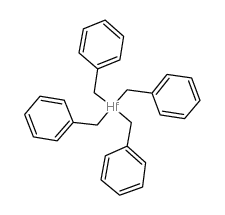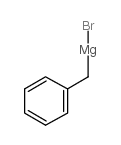31406-67-4
| Name | hafnium(4+),methanidylbenzene |
|---|---|
| Synonyms |
halfnium tetrabenzyl
Hafnium,tetrakis(phenylmethyl)-,(T-4) hafnium tetrabenzyl tetra(benzyl)hafnium Hafnium,tetrabenzyl-(8CI) |
| Melting Point | 99-104ºC(lit.) |
|---|---|
| Molecular Formula | C28H28Hf |
| Molecular Weight | 543.01200 |
| Exact Mass | 544.16600 |
| LogP | 8.00920 |
|
Section 1: Product Identification Chemical Name:Tetrabenzylhafnium, min. 97% CAS Registry Number:31406-67-4 Formula:C28H28Hf EINECS Number:none Chemical Family:organometallic complex Synonym:none
Section 2: Composition and Information on Ingredients IngredientCAS NumberPercentACGIH (TWA)OSHA (PEL) Title compound31406-67-4100%0.5mg/m3 (as Hf)0.5mg/m3 (as Hf) Section 3: Hazards Identification Emergency Overview:May be irritating to skin, eyes and respiratory tract. May be harmful if swallowed. Primary Routes of Exposure:Ingestion, inhalation Eye Contact:May cause slight to mild irritation of the eyes. Skin Contact:May cause slight to mild irritation of the skin. Inhalation:May be irritating to the nose, mucous membranes and respiratory tract. Ingestion:No information is available on the physiological effects of ingestion. Acute Health Affects:May be irritating to skin, eyes, mucous membranes, and respiratory tract. Chronic Health Affects:No information available on long-term chronic effects. NTP:No IARC:No OSHA:No SECTION 4: First Aid Measures Immediately flush the eyes with copious amounts of water for at least 10-15 minutes. A victim may need Eye Exposure: assistance in keeping their eye lids open. Get immediate medical attention. Wash the affected area with water. Remove contaminated clothes if necessary. Seek medical assistance if Skin Exposure: irritation persists. Remove the victim to fresh air. Closely monitor the victim for signs of respiratory problems, such as difficulty Inhalation: in breathing, coughing, wheezing, or pain. In such cases seek immediate medical assistance. Seek medical attention immediately. Keep the victim calm. Give the victim water (only if conscious). Induce Ingestion: vomiting only if directed by medical personnel. SECTION 5: Fire Fighting Measures Flash Point:none Autoignition Temperature:none Explosion Limits:none Extinguishing Medium:carbon dioxide, dry powder or foam Fire fighters should be equipped with a NIOSH approved positive pressure self-contained breathing apparatus Special Fire Fighting Procedures: and full protective clothing. Hazardous Combustion andIf involved in a fire this material may emit toxic fumes of carbon monoxide, and hafnium oxide. Decomposion Products: Unusual Fire or Explosion Hazards: Flammable solid. Evolves flammable tetramethylcyclopentadiene with water. SECTION 6: Accidental Release Measures Keep away from sources of ignition. Small spills can be mixed with vermiculite, sodium carbonate or other Spill and Leak Procedures: suitable noncombustible adsorbent and swept up. Do not raise dust. SECTION 7: Handling and Storage Store the material under an inert atmosphere of nitrogen or argon in a tightly sealed container. Store cold to Handling and Storage: maximize shelf life. SECTION 8: Exposure Controls and Personal Protection Eye Protection:Always wear approved safety glasses when handling a chemical substance in the laboratory. Skin Protection:Wear protective clothing and gloves. Consult with glove manufacturer to determine the proper type of glove. Ventilation:Handle the material under an inert atmosphere of nitrogen or argon. If ventilation is not available a respirator should be worn. The use of respirators requires a Respirator Respirator: Protection Program to be in compliance with 29 CFR 1910.134. Ventilation:Handle the material under an inert atmosphere of nitrogen or argon. Additional Protection:No additional protection required. SECTION 9: Physical and Chemical Properties Color and Form:yellow pwdr. Molecular Weight:543.01 Melting Point:no data Boiling Point:no data Vapor Pressure:no data Specific Gravity:no data Odor:not determined Solubility in Water:insoluble SECTION 10: Stability and Reactivity Stability:air, moisture and heat sensitive (store cold) Hazardous Polymerization:no hazardous polymerization Conditions to Avoid:heat and ignition sources, air, and moisture Incompatibility:strong oxidizing agents, mineral acids and halogens. Decomposition Products:hafnium oxide, carbon monoxide, carbon dioxide and organic fumes. SECTION 11: Toxicological Information RTECS Data:No information available in the RTECS files. Carcinogenic Effects:no data Mutagenic Effects:no data Tetratogenic Effects:no data SECTION 12: Ecological Information Ecological Information:No information available SECTION 13: Disposal Considerations Disposal:Dispose of according to federal, state, and local regulations. SECTION 14: Transportation Shipping Name (CFR):Flammable solids, Inorganic, N.O.S. Hazard Class (CFR):4.1 Additional Hazard Class (CFR):NA Packaging Group (CFR):II UN ID Number (CFR):UN# 3178 Shipping Name (IATA):Flammable solid, Inorganic, N.O.S. Hazard Class (IATA):4.1 Additional Hazard Class (IATA):NA Packaging Group (IATA):II UN ID Number (IATA):UN# 3178 SECTION 15: Regulatory Information TSCA:Not listed in the TSCA inventory. SARA (Title 313):Title compound not listed. Second Ingredient:none SECTION 16 - ADDITIONAL INFORMATION N/A |
|
~61% 
31406-67-4 |
| Literature: Gmelin Handbook: Hf: Org.Verb., 1.1, page 1 - 2 |
|
~67% 
31406-67-4 |
| Literature: Univation Technologies, LLC Patent: US7067686 B1, 2006 ; Location in patent: Page/Page column 9-10; 11 ; |
| HS Code | 2902909090 |
|---|---|
| Summary | 2902909090 other aromatic hydrocarbons。Supervision conditions:None。VAT:17.0%。Tax rebate rate:9.0%。MFN tariff:2.0%。General tariff:30.0% |


